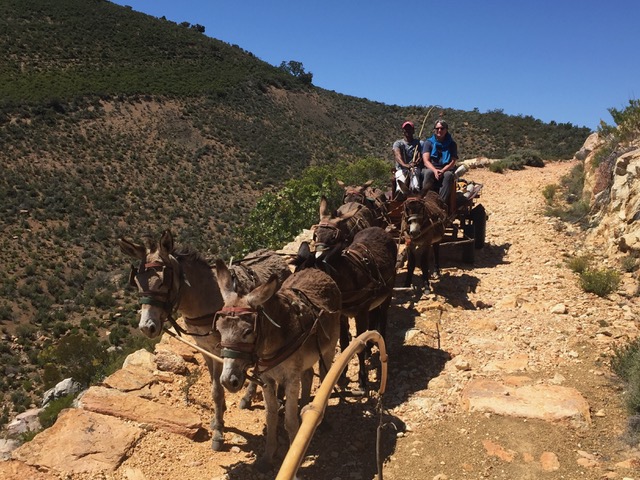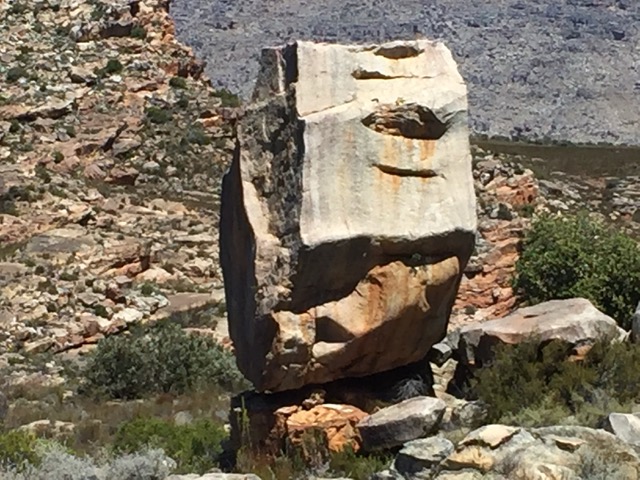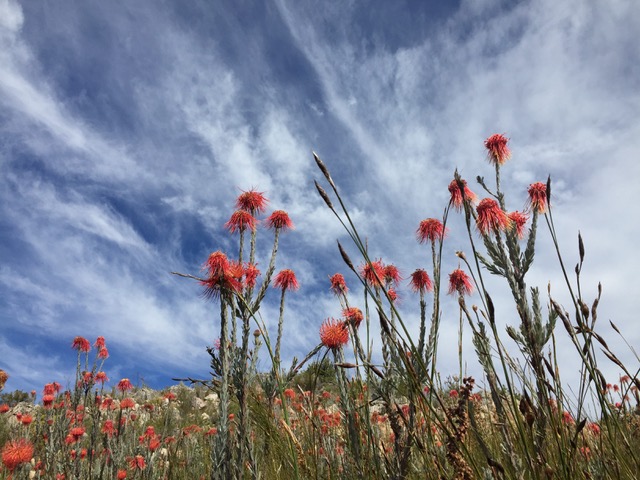Listening in is irresistible but feels transgressive, as if I am eavesdropping on a private conversation between intimates… Gert Theron, the donkey whisperer of Heuningvlei, is alternately threatening and cajoling the six donkeys racing along a rough track addressing each by name: Geweld and Trapnet lead the pack; behind them are Potlood and President. Beaufort and Willem bring up the rear. Gert urges each in turn, his voice rhythmic, intense, hypnotic; punctuated with a multi-syllabic grunt that sounds more donkey than human. In the background is the thundering of six sets of hooves on flinty surfaces.

Image Liz McGregor

Image Liz McGregor
From my viewpoint, perched behind him in the hand-made wooden cart, the urgency in his voice feels appropriate. The track is narrow and boulder-strewn, with a precipitous drop to the right. Far in the distance is the Pakhuis Pass, our final destination. One of the straps on the ancient leather harnesses tethering the donkeys to the cart and to each other snaps and we stop and off-load while Gert replaces it with a length of rope he keeps in his pocket. The pace is fast and furious – up and down hills, through gushing streams. The views are spectacular and the thrill far outweighs the occasional flash of terror.
The donkey cart ride is the last stage of the Groot Krakadouw Trail in the northern Cederberg mountains. I’ve been on many great hiking trails but this tops them all. The best bit – aside from the towering mountains, the endless varieties of fynbos and the crystal clear mountain streams – is that you stay and walk with and are fed by the communities who have lived in these little mountain villages for generations.
The Groot Krakadouw is one of six slackpacking trails of varying intensity and duration run by a non-profit organisation, the Cederberg Heritage Route.
We had booked this mid-October hike before Covid struck and it wasn’t clear until shortly before the hike was due to start whether or not it would go ahead. We were the first post-lockdown visitors and there was, understandably, some anxiety among mountain communities as to whether it would be safe to admit us urbanites to their homes.
Some of them declined and adjustments had to be made. Instead of spending our first night at Boskloof at the foot of the Krakadouw Pass, we stay at a guesthouse in Clanwilliam, the Yellow Aloe. We’re given R200 vouchers for dinner at Michaels on Park, the only restaurant to survive lockdown, where we eat chicken pie and bobotie, washed down with a delicious Cederberg sauvignon blanc.
Early the following morning, a minibus taxi drives us to Boskloof where guides are waiting to lead us up the pass. This is the steepest climb of the hike: we ascend some 900m, but much of it is gradual. Alongside us tumbles the Dwarsrivier stream, swollen by plentiful winter rains, and providing a steady supply of spring water for our bottles. Our guides are lovely: equally patient with the stragglers and the striders and full of interesting local lore. At one point, Barend, the head guide, stops at a pile of white cylindrical droppings: leopard, he says, two days old. Ryno, the second guide, keeps a look-out for snakes, his speciality. He had kept two cobras in his house until his girlfriend objected. He points out the rooibos, which grows wild up here, and explains the process by which it is turned into tea.
Mid-afternoon, we reach Heuningvlei, their home village, a cluster of thatched, white-washed houses. Our home for the next two nights is the former primary school, converted into a lodge, where we are welcomed by a smiling young woman, who introduces herself as Renee. The few remaining children in the village, she explains, attend junior school in Wupperthal and senior school in Clanwilliam.
We sit on the verandah and ease boots off our aching feet. Sipping gin and tonic – the latter having been put in the fridge for us in the morning – we watch village life slide by. Fat sheep wander past; birds chatter in the tall tree opposite. In the distance, a man tills a field – the villagers each have a plot on which they grow vegetables, beans, maize and rooibos.
There are four clean and comfortable bedrooms for the eight of us. After hot showers, we light a fire in the living room and, at 6.45pm, Renee, with a friend and a procession of curious children, arrives with our dinner – meatballs, fried chicken, roast potato, butternut, green beans and salad, and fruit salad with custard for dessert. After breakfast the following morning – scrambled eggs, boerewors, toasted home-made bread, cheese and jam – we are given packed lunches of sandwiches, boiled eggs, apples and carton juice.
At 8am, our guides arrive for a day described as easy: a 10km ramble in the mountains around Heuningvlei. Stand-outs are, for me, the San paintings hidden high in the rocky outcrops. Clambering up over boulders behind our guide, we are treated to private viewings of these extraordinary, ancient artworks, painted in ochre more than 2,000 years ago. One is of human figures tugging at the tail of an over-sized elephant, presumably reflecting a time when elephants still roamed here. Another depicts two priapic male figures, possibly indicating a shamanic fertility rite.

There were extraordinary rock formations around every corner (Image Liz McGregor)

Bushmen art: Priapic San, possibly depicting a fertility rite (Image Liz McGregor)

Bushmen art: an elephant painting (Image Liz McGregor)
The human footprint on this 100km-long mountain range is remarkably light. It is a designated wilderness area so there is little development aside from the small villages originally established as mission outposts. Much of the land is owned by the Moravian Church who inherited it in 1960 from the Rhenish Mission Society, a German grouping who arrived in South Africa in 1830. They bought up a series of farms in the Western Cape, and these became havens for the indigenous San and Khoi people dispossessed of the hunting and grazing land by first the Dutch colonists and then the British. In 1838, their ranks were swelled by freed slaves. The missionaries provided homes and harvested souls. The mixed ancestry of these early inhabitants – San, Khoi, European and African – is still hinted at in the features of some of the current residents.
Back at Heuningvlei in the evening, Renee introduces us to Geraldine, who is to provide that night’s meal and the following day’s breakfast and lunch. We ask if it is possible to have oats for breakfast and the following morning, it arrives, in addition to the usual fare.
Shortly afterwards, our guides arrive to lead us to our next stop-over, Brugkraal. Community members who provide services such as catering and guiding are paid extra and it seems this bounty is fairly shared out.
Handovers are always smooth and seamless. Modern means of communication have not reached all parts of the Cederberg – often, there is no cellphone coverage and no internet connection; there is only the odd landline. Yet this doesn’t seem to hinder communication. Everyone involved is punctual and efficient. The guides assigned to each daily walk arrive at the appointed hour, as does the vehicle transporting our luggage from one destination to the next. There only seems to be one per village – sturdy 4x4s capable of negotiating some very rough roads. Donkeys are the transport mainstay.
Eight hours later, after a 17km hike through an otherworldly landscape, through flat plains and deep ravines, flanked by dramatic sandstone cliffs, we reach Brugkraal where the Manuel family host us in a well-equipped, five-bedroomed house. There is hot water in all three bathrooms and fresh linen on the beds. At this stop, we have to do our own catering and our supplies are waiting in the kitchen. We eat lentil curry and fruit salad around a fire in the garden, lingering on this last night together, over wine and whisky.

Rocket pincushion aka perdekoppe (Image Liz McGregor)

A stream (Image Liz McGregor)

Leopard droppings (Image Liz McGregor)
The following morning, we hike back to Heuningvlei where the donkeys are waiting to transport us and our luggage on the last leg.
When we get to the top of the Pakhuis Pass and Roscoe, the driver of the second cart, frees the donkeys so that they can rest and graze in preparation for the journey home. Once there, they will head for the hills, running wild until they are hauled in to work again.
We collect our bags and walk up the hill to where a sanitised taxi is waiting to take us back to Clanwilliam. As the town gets closer, cellphones start to ping for the first time in four days, letting in anxious Covid updates and the latest Trumpian outrage. Oh, to be back in the mountains again! DM/ ML
For more information about the hike, you can contact Michelle Truter on [email protected] or click here.
Gert Theron’s Found Poetry, transcribed by Odette Geldenhuys and Tony Trew
Tra net, Gewild, President!
Die plek spook kinders!
Skiet agteruit en vooruit
Die trein trap uit die spoor uit
Beaufort, weg!
Ons kap daai eerste, kind
ah hahh
Tra net, Gewild
Die plek spook kinders, die plek spook
ah hah
Ons vat hom soos manne!
Ons vat hom soos mannne, President
ah hahh
Gewild, President, Gewild, President
Die plek spook kinders, die plek spook
ah hah
Ons moet hier uit
Ons moet hier uit
Skyt skyt!


















 Become an Insider
Become an Insider
So enjoyed this article and pics – The Groot Krakadouw Trail sounds like an adventure worth having !
I listened to the article. Nicely read – except for the poem at the end where this pukka English speaker reads, i.e. ruins, this lovely Afrikaans poem.